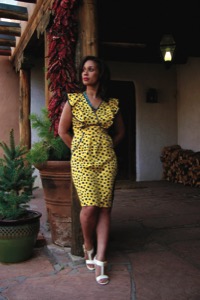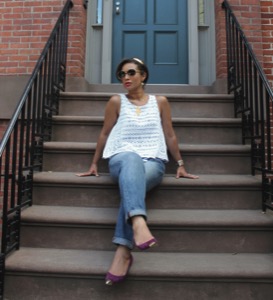
Jayden Smith’s breakthrough moment has arrived. Thanks to a Louis Vuitton fashion campaign, this gender-fluid fashion rock star, son to actor Will Smith, isn’t just a symbol of a new, sexually uninhibited generation, he’s an expression of a growing awareness in fashion that gender constraints no longer make sense whether it be in models, marketing or materials.
Not that you have to sell Anita Dolce Vita on any of this. The founder of dapperQ, a highly-regarded sartorial blog with an emphasis on gender identity-less clothing for women of all sexual and gender identities, Anita is also a force within fashion, pushing boundaries that need to be pushed in an uncompromising but thoroughly satisfying way.
Anita recently spoke at the South by Southwest (SxSW) Festival in Austin, Texas in a festival first: She headlined a queer style panel that addressed the limiting – and self-defeating – norms of au courant fashion by making the argument that gender binaries need to unravel if we are to achieve fashion parity by representing clothes for all of the people and not just a world where women wear traditional women’s clothing and vice-versa for men.
We spoke with Anita about fashion constraints, past and present, the future of genderless fashion and its viability among other choice morsels and found space for this article the only barrier for a conversation that could have gone on much, much longer.
San Diego LGBT Weekly: So, how did the panel go?
Anita Dolce Vita: Our team, which featured eight prominent queer style leaders, including myself representing dapperQ (NYC); Sonny Oram of Qwear (Boston); Aja Aguirre of Fit for a Femme (Boston by way of The Bay); and Leon Wu of Sharpe Suiting (Los Angeles), felt the panel was very successful and well attended. We achieved our mission of starting conversations about queer style as a form of visual activism that creates positive social change.
What sorts of questions were asked? Was there one question and/or answer that stuck out?
As the moderator, I started a dialogue about how fashion and health intersect. There is a new body of research known as enclothed cognition, which examines how clothing impacts our psychological processes. For example, one study revealed that subjects perform better on tasks when they wear a white coat believed to be a doctor’s coat. The same study found no performance improvements when subjects were told that the same exact coat was a painter’s coat. Style is more than cultural and political on a macro-level, but can have a profound impact on our psychological well-being. I think one of the most impactful moments during the panel is when I asked Sonny to share a story of improved personal health and happiness within the context of enclothed cognition and queer style.

The audience also asked some poignant questions. One of the most memorable came from two bloggers from Unicorn Booty. They wanted to know how to leverage platforms to address elitist and often racist dress codes that are being enforced by LGBTQ bars and party promoters. The language is often coded, for example, “no sagging pants allowed.” I shared with them a similar issue our community faced in New York. A party promoter published an invite that specifically stated that femmes could not attend the event unless they wore heels. The community responded by speaking out against femme-phobia and gender policing. While the promoters refused to back down, the community all rallied on social media to open dialogues about femme-phobia and harmful binaries that exist within our very own circles.
Did you meet anyone you had wanted/hoped to meet? If so who, and why them?
Yes! SxSW is an extraordinary networking opportunity. I was thrilled that SxSW planned LGBTQ meetups and POC blogger breakout groups. But, I think I had a super fan-girl moment when I met queer designer Becca McCharen of Chromat, who has designed for mega-stars like Beyoncé and Gaga! I also got to ask Ashley Graham – the first plus size model to grace the cover of Sports Illustrated’s swimsuit issue – a question about how to advance disruptive beauty efforts and anti-oppression fashion movements within existing, problematic platforms. I think it’s fantastic that Graham was on the cover of Sports Illustrated, but like my partner asked, “Why does Sports Illustrated have a swimsuit issue anyway?” Ashley’s response was insightful and empowering.
In the pre-SxSX press release, you are quoted as saying, “Queer style is most certainly its own genera that cannot simply be reduced to white, cis, gay male fashion designers creating predictable binary, gender normative, heteronormative collections to fit the fashion industry’s unattainable beauty ideals. Queer style dismantles limiting style rules that have been systematically employed as a means of symbolically and literally perpetuating restrictive binaries and oppressing freedom of expression.” Do you see in your lifetime that happening? A new reality where everyone is fully accepting as far as fashion and the role of the model in it goes?
Well, I’m optimistically pessimistic. We have made progress with respect to breaking down binaries in fashion. In the beginning of the 20th century, conservatives warned that allowing women to wear pants would emasculate men and destroy the family. And, though women wearing pants is commonplace today, provided women still present feminine overall, we have yet to get to a place where society would find it acceptable for a man to wear a dress to work. People can still be legally discriminated against in many states for dressing outside the binary, and there is an epidemic of trans-women being murdered. We have a lot of work to do.
At a gut level, why do you think this prejudice exists? I’m thinking particularly about a remark Candice made on Facebook, which dapperQ reprinted, in response to William Van Meeter’s maladroit handling of 2010’s “Year of The Transexual” in The New York Times. She wrote, “How can 2010 be the ‘year of the transsexual’ when trans people are murdered and disrespected nonstop? And when we still use the much medicalized term ‘transsexual’ to describe a wide umbrella of gender difference? And when people are stared at and ridiculed for crossing people’s rigid ideas of what it means to be a man or woman?” Have there been strides at all in the advancement of gender non-conformity since the piece was penned back in 2010?
There have been strides. We have trans icons like Laverne Cox as a household name and gracing the cover of Time. This visibility is a small step toward starting conversations and opening hearts and minds. But, as I mentioned before, we have so much more work to do. Trans people are still disproportionately targets of violence, people still can get fired for dressing outside of acceptable gender norms and even within the queer community we are guilty of perpetuating masculine/feminine hierarchies and binaries.
This brings me to the first half of your question. At a gut level, I think this prejudice exists because of homophobia and misogyny. In our culture, men and women must fit into very limiting, restrictive gender roles. The patriarchy has a vested interest in upholding the binary and protecting the hierarchy. If your gender expression, gender identity or sexual orientation challenges this hierarchy, you threaten existing power structures. Anything that threatens oppressive power structures is often met with prejudice, discrimination and violence.

Are you happy with how things have turned out for you thus far in life?
I’d say I’m very happy! My mother was a drug addict. My father was not an active part of my life. I grew up poor in Albuquerque. I was the first person in my family to graduate college and I have three degrees, including an MPA from NYU, all conferred with honors. I live in New York City, I have a fantastic fiancée who is as smart as she is gorgeous and two cats that I love like children. I get to travel and blog and speak. And, I’m a research nurse, so I get to save lives by improving the future of healthcare. I’d say, I done pretty good.
More at dapperq.com











